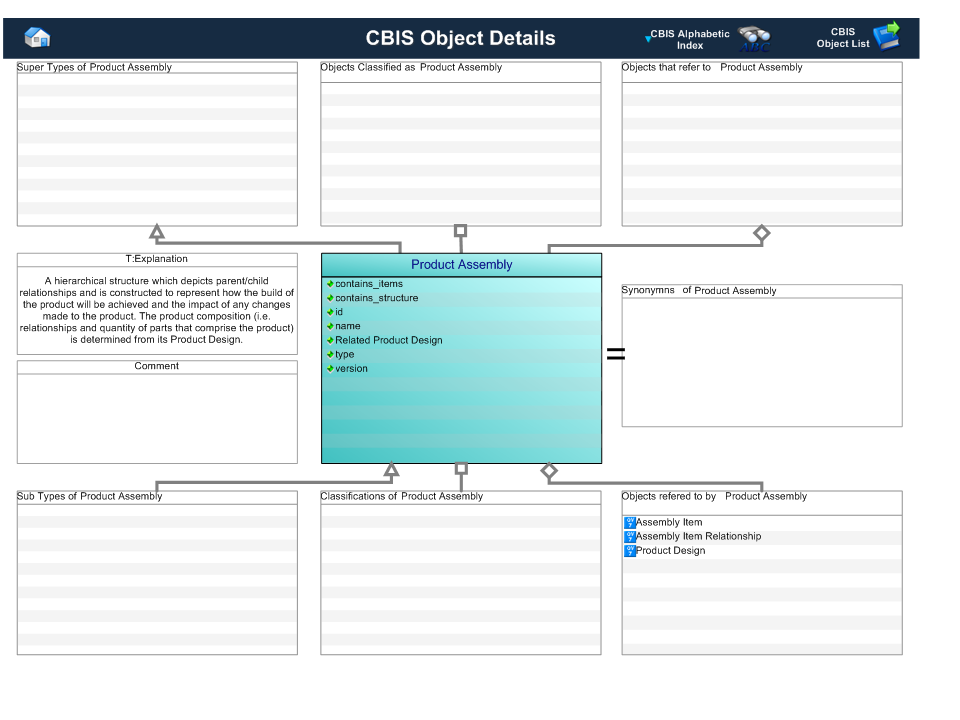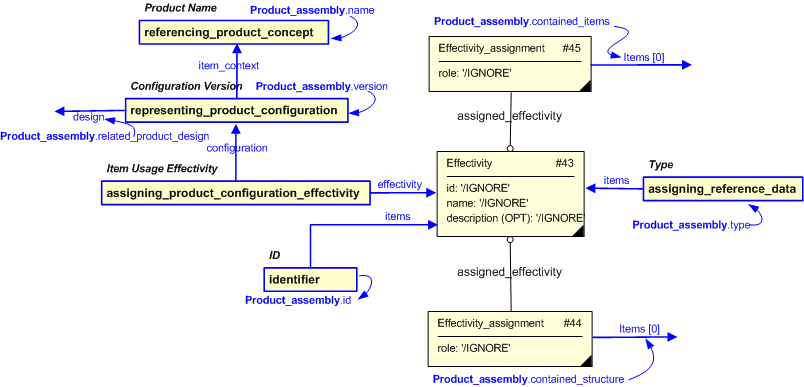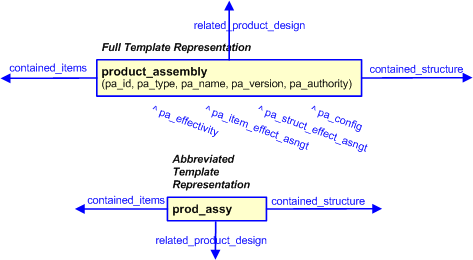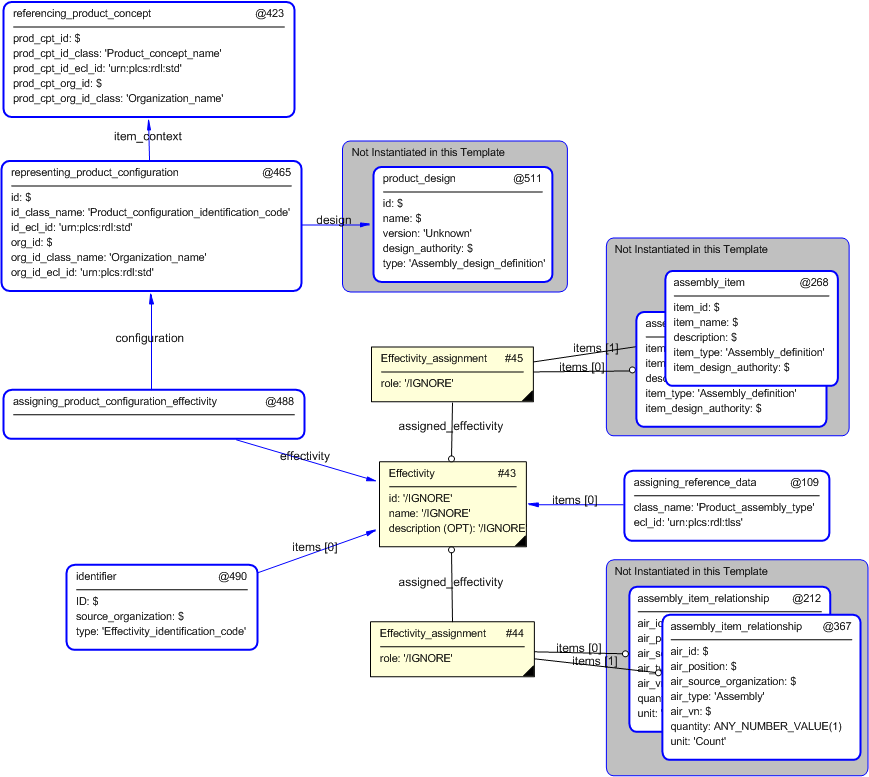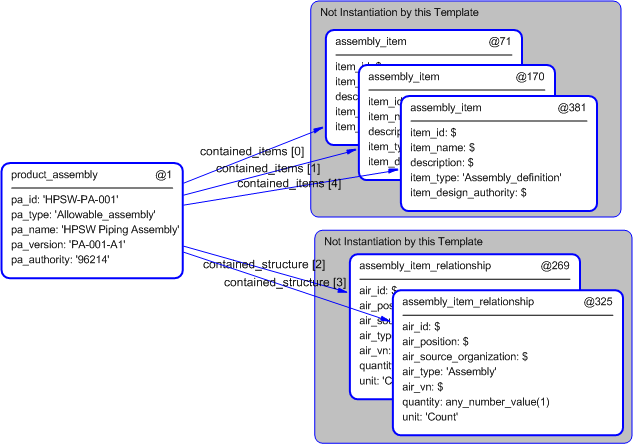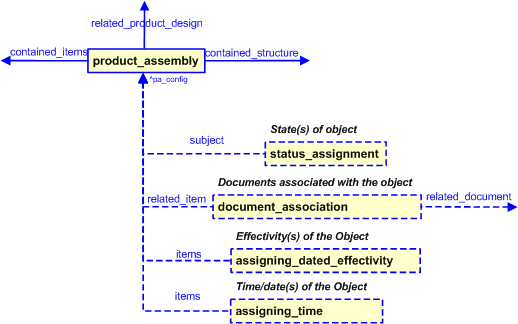Template:— product_assembly (prod_assy)
Context:— UK_Defence |
Date: 2010/03/18 12:20:27
Revision: 1.3
|
This section specifies the template product_assembly.
NOTE
The template has been defined in the context of
UK_Defence.
Refer to the business context for details of related templates.
NOTE
An explanation of a template and the associated instantiation path is
provided in the
Template overview
section.
This template describes how to represent the UK_Defence concept of a product assembly
in terms of PLCS model elements (templates, entities, and reference data).
This information object collects together Assembly Item Relationship (structures) and Assembly Items for a named product structure.
The Assembly structures provide the valid relationships and items for a type of configuration for a given product design.
and is constructed to represent how the build of the product will be achieved and the impact of any changes made to the product.
A hierarchical structure which depicts parent/child relationships and is constructed to represent how the build of the product
will be achieved and the impact of any changes made to the product.
Figure 1 — Graphical Representation for Business Object Product Assembly.
|
Attribute name
|
Attribute description
|
Attribute type
|
Optionality
|
| contained_items |
This attribute identifies the valid items (Assembly Items) in the assembly. |
Assembly Item |
Mandatory |
| contained_structure |
This attribute identifies the valid structures (Assembly Item Relationships) in the assembly. |
Assembly Item Relationship |
Mandatory |
| ID |
This attribute provides the identification of a valid Product Assembly that is effective for a type of configuration. |
Identifier |
Mandatory |
| Identifier.id |
This is the value of the id attribute of the Identifier applied to a Product Assembly. |
intrinsic |
Mandatory |
| Identifier.type |
This attribute is the type associated with the id of the Identifier given to the Product Assembly. This value is assumed to
be a type of Effectivity_identification_code.
|
Effectivity_identification_code |
Mandatory |
| Identifier.source_organization |
This attribute is the value representing the source organization that provides the id of the Identifier given to the Product
Assembly. This value is assumed to be a type of Organization_identification_code.
|
Organization_identification_code |
Mandatory |
| name |
This attribute provides the name of the Product Assembly. |
Intrinsic |
Mandatory |
| related_product_design |
This attribute relates the Product Assembly to the defined version of a Product Design. |
Product Design |
Mandatory |
| type |
This attribute provides the type of Product Assembly. |
Intrinsic |
Mandatory |
| version |
This attribute provides the version of the Product Assembly configuration that is effective for the given items and structures
of a Product Design.
|
Intrinsic |
Mandatory |
Table 1 — Product Assembly attribute details
The EXPRESS-G diagram in
Figure
2
shows the templates and EXPRESS entities that are required
to represent the template
"product_assembly".
The text highlighted in blue shows the template parameters.
Figure 2 — An EXPRESS-G representation of the Information model for product_assembly
The graphic for the template to be used in other EXPRESS-G diagrams
is shown in Figure
3
below.
Figure 3 — The graphical representation of the product_assembly template
The following input parameters are defined for this template:
pa_type (Default=Product_assembly,Type='CLASS')
The type of Product Assembly. The types provided should be determined by the exchange partners or organization(s) business
usage requirements. Examples have been provided.
The name of the product for which the assembly is configured.
The version of the Product Assembly configuration.
The ncage identifier of the design authority that determines the validity of a product assembly configuration.
A list of the valid Assembly Items for a particular configuration of the given design for a particular product design.
The Assembly Item business object is expressed as a
Part_view_definition. Different Assembly Items may be valid in different types or versions of the Product Assembly configuration.
A list of the valid Assembly Item Relationships (structures) for a particular configuration of the given design
for a particular product design. The Assembly Item Relationship business object is expressed as a
Next_assembly_usage. Different Assembly Item Relationships may be valid in different types or versions of the Product Assembly configuration.
The defined version of the Product Design for the Product Assembly configuration.
The following reference parameters are defined for this template:
Allow the
Effectivity
entity instantiated in this path to be referenced when this template is used.
Note: The
Effectivity
entity can be referenced in a template path by:
%^target = $product_assembly.pa_effectivity%
where
target
is the parameter to which the
Effectivity
is bound.
Allow the
Effectivity_assignment
entity instantiated in this path to be referenced when this template is used.
%^target = $product_assembly.pa_item_effect_asngt%
Allow the
Effectivity_assignment
entity instantiated in this path to be referenced when this template is used.
%^target = $product_assembly.pa_struct_effect_asngt%
%^target = $product_assembly.pa_config%
The instantiation path shown below specifies the entities that are to be
instantiated by the template.
A description of templates and the syntax for the instantiation path is
provided in the
Templates Help/Information section.
%^pa_effectivity =
Effectivity%
Effectivity.id = '/IGNORE'
Effectivity.name = '/IGNORE'
Effectivity.description = '/IGNORE'
-- New Effectivity assignment Effectivity_assignment.role = '/IGNORE'
Effectivity_assignment.items ->
@contained_items-- Set the Effectivity_assignment attribute role to be ignored Effectivity_assignment.role = '/IGNORE'
-- Instantiate Effectivity_assignment entity (no.1) %^pa_item_effect_asngt =
Effectivity_assignment%
^pa_item_effect_asngt.assigned_effectivity ->
^pa_effectivity
/
identifier(
items=^pa_effectivity,
ID=@pa_id,
type='Effectivity_identification_code',
source_organization=@pa_authority)/
-- /identifier(items=^pa_effectivity, ID=@pa_name, type='Name', source_organization=@pa_authority)/ -- /identifier(items=^pa_effectivity, ID=@pa_version, type='Version_identification_code', source_organization=@pa_authority)/
-- provide the role of the identification by classifying the Identification_assignment /
assigning_reference_data(
items=^pa_effectivity,
class_name=@pa_type,
ecl_id='urn:plcs:rdl:uk_defence')/
-- create the ref to the product concept /
referencing_product_concept(
prod_cpt_id=@pa_name,
prod_cpt_id_class='Product_concept_name',
prod_cpt_id_ecl_id='urn:plcs:rdl:std',
prod_cpt_org_id=@pa_authority,
prod_cpt_org_id_class='Organization_name',
prod_cpt_id_ecl_id='urn:plcs:rdl:std')/
%^pa_ref_concept = $referencing_product_concept.prod_cpt%
/
representing_product_configuration(
design=@related_product_design,
item_context=^pa_ref_concept,
id=@pa_version,
id_class_name='Product_configuration_identification_code',
id_ecl_id='urn:plcs:rdl:std',
org_id=@pa_authority,
org_id_class_name='Organization_name',
org_id_ecl_id='urn:plcs:rdl:std')/
%^pa_config = $representing_product_configuration.item_desgn_assoc%
/
assigning_product_configuration_effectivity(
configuration=^pa_config,
usage=$,
effectivity=^pa_effectivity)/
Effectivity_assignment.role = '/IGNORE'
Effectivity_assignment.items ->
@contained_structureEffectivity_assignment.role = '/IGNORE'
-- Make Ref Params of Effectivity_assignment entity (no.2) %^pa_struct_effect_asngt =
Effectivity_assignment%
The following entities are instantiated with attributes as specified:
The instance diagram in Figure
4
shows an example of the EXPRESS entities and templates that are instantiated by the template:
/product_assembly(pa_id='HPSW-PA-001', pa_type='Allowable_assembly', pa_name='HPSW Piping Assembly', pa_version='PA-001-A1', pa_authority='96214', contained_items='(@71, @170, @381)', contained_structure='(@269, @325)', related_product_design='$')/
(an illustration of the consolidated product_assembly template is shown in
Figure
5 below.)
Figure 4 — Entities instantiated by product_assembly template
The instance diagram in
Figure
5
shows the graphic symbol for the template that is to be
used in other instance diagrams. The example template is:
/product_assembly(pa_id='HPSW-PA-001', pa_type='Allowable_assembly', pa_name='HPSW Piping Assembly', pa_version='PA-001-A1', pa_authority='96214', contained_items='(@71, @170, @381)', contained_structure='(@269, @325)', related_product_design='$')/
Figure 5 — Instantiation of product_assembly template
The following section details how the
product_assembly
template can be optionally characterized by assigning
other constructs to it. These are characterizations commonly
applied to the template. The ISO 10303-239 EXPRESS model may enable
other assignments to the entities instantiated by the template.
The EXPRESS-G diagram in Figure
6
shows the possible characterizations of the template
"product_assembly".
Figure 6 — Characterizations for product_assembly
The following characterizations may apply:
Characterization Status Assignment
NOTE this characterization is optional.
A UK_Defence.product_assembly
may have one or more status assigned to it, through the use of the following templates (or those based upon these):
UK_Defence.status_assignment.
The following template calls show how these characterizations
might be instantiated.
/status_assignment(assigned_status='', assigned_status_ecl_id='', ID='', ID_type='', ID_organization='', subject='', type='', type_ecl_id='')/
Characterization Document Association
NOTE this characterization is optional.
A UK_Defence.product_assembly
may have specific documents assigned to it, through the use of the following templates (or those based upon these): UK_Defence.document_association
, and the associated UK_Defence.document
. The following template calls show how these characterizations
might be instantiated.
/document_association(id='', type='', source_organization='', purpose='', related_document='', related_item='')/
Characterization Assigning effectivity
NOTE this characterization is optional.
Characterization Assigning date
NOTE this characterization is optional.
